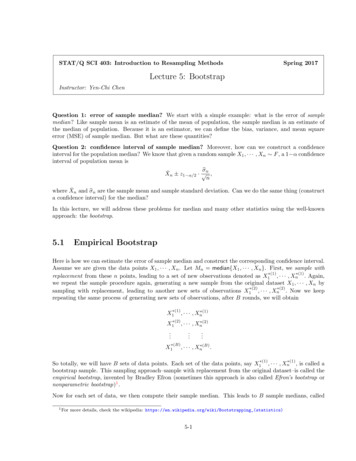
Transcription
BOOTSTRAP046AContents1. Introduction2. Conventions3. Morphisms representable by algebraic spaces4. Properties of maps of presheaves representable by algebraic spaces5. Bootstrapping the diagonal6. Bootstrap7. Finding opens8. Slicing equivalence relations9. Quotient by a subgroupoid10. Final bootstrap11. Applications12. Algebraic spaces in the étale topology13. Other chaptersReferences11256910111214162124251. Introduction046BIn this chapter we use the material from the preceding sections to give criteriaunder which a presheaf of sets on the category of schemes is an algebraic space.Some of this material comes from the work of Artin, see [Art69b], [Art70], [Art73],[Art71b], [Art71a], [Art69a], [Art69c], and [Art74]. However, our method will be touse as much as possible arguments similar to those of the paper by Keel and Mori,see [KM97].2. Conventions046CThe standing assumption is that all schemes are contained in a big fppf site Sch f ppf .And all rings A considered have the property that Spec(A) is (isomorphic) to anobject of this big site.Let S be a scheme and let X be an algebraic space over S. In this chapter and thefollowing we will write X S X for the product of X with itself (in the category ofalgebraic spaces over S), instead of X X.This is a chapter of the Stacks Project, version 03fc22eb, compiled on May 27, 2021.1
BOOTSTRAP23. Morphisms representable by algebraic spaces02YPHere we define the notion of one presheaf being relatively representable by algebraicspaces over another, and we prove some properties of this notion.02YQDefinition 3.1. Let S be a scheme contained in Sch f ppf . Let F , G be presheaveson Sch f ppf /S. We say a morphism a : F G is representable by algebraic spacesif for every U Ob((Sch/S)f ppf ) and any ξ : U G the fiber product U ξ,G F isan algebraic space.Here is a sanity check.03BNLemma 3.2. Let S be a scheme. Let f : X Y be a morphism of algebraicspaces over S. Then f is representable by algebraic spaces.Proof. This is formal. It relies on the fact that the category of algebraic spacesover S has fibre products, see Spaces, Lemma 7.3. 03Y0Lemma 3.3. Let S be a scheme. LetG0 G Fa0 G0/Fa /Gbe a fibre square of presheaves on (Sch/S)f ppf . If a is representable by algebraicspaces so is a0 .Proof. Omitted. Hint: This is formal.02YR Lemma 3.4. Let S be a scheme contained in Sch f ppf . Let F, G : (Sch/S)oppf ppf Sets. Let a : F G be representable by algebraic spaces. If G is a sheaf, then sois F .Proof. (Same as the proof of Spaces, Lemma 3.5.) Let {ϕi : Ti T } be a coveringof the site (Sch/S)f ppf . Let si F (Ti ) which satisfy the sheaf condition. Thenσi a(si ) G(Ti ) satisfy the sheaf condition also. Hence there exists a uniqueσ G(T ) such that σi σ Ti . By assumption F 0 hT σ,G,a F is a sheaf. Notethat (ϕi , si ) F 0 (Ti ) satisfy the sheaf condition also, and hence come from someunique (idT , s) F 0 (T ). Clearly s is the section of F we are looking for. 05LALemma 3.5. Let S be a scheme contained in Sch f ppf . Let F, G : (Sch/S)oppf ppf Sets. Let a : F G be representable by algebraic spaces. Then F/G : F F G Fis representable by algebraic spaces.Proof. (Same as the proof of Spaces, Lemma 3.6.) Let U be a scheme. Letξ (ξ1 , ξ2 ) (F G F )(U ). Set ξ 0 a(ξ1 ) a(ξ2 ) G(U ). By assumption thereexist an algebraic space V and a morphism V U representing the fibre productU ξ0 ,G F . In particular, the elements ξ1 , ξ2 give morphisms f1 , f2 : U V over U .Because V represents the fibre product U ξ0 ,G F and because ξ 0 a ξ1 a ξ2we see that if g : U 0 U is a morphism theng ξ1 g ξ2 f1 g f2 g.In other words, we see that U ξ,F G F F is represented by V ,V V,(f1 ,f2 ) U whichis an algebraic space.
BOOTSTRAP3The proof of Lemma 3.6 below is actually slightly tricky. Namely, we cannot usethe argument of the proof of Spaces, Lemma 11.3 because we do not yet know thata composition of transformations representable by algebraic spaces is representableby algebraic spaces. In fact, we will use this lemma to prove that statement.02YSLemma 3.6. Let S be a scheme contained in Sch f ppf . Let F, G : (Sch/S)oppf ppf Sets. Let a : F G be representable by algebraic spaces. If G is an algebraic space,then so is F .Proof. We have seen in Lemma 3.4 that F is a sheaf.Let U be a scheme and let U G be a surjective étale morphism. In this caseU G F is an algebraic space. Let W be a scheme and let W U G F be asurjective étale morphism.First we claim that W F is representable. To see this let X be a scheme and letX F be a morphism. ThenW F X W U G F U G F F X W U G F (U G X)Since both U G F and G are algebraic spaces we see that this is a scheme.Next, we claim that W F is surjective and étale (this makes sense now that weknow it is representable). This follows from the formula above since both W U G F and U G are étale and surjective, hence W U G F (U G X) U G Xand U G X X are surjective and étale, and the composition of surjective étalemorphisms is surjective and étale.Set R W F W . By the above R is a scheme and the projections t, s : R Ware étale. It is clear that R is an equivalence relation, and W F is a surjectionof sheaves. Hence R is an étale equivalence relation and F W/R. Hence F is analgebraic space by Spaces, Theorem 10.5. 03XYLemma 3.7. Let S be a scheme. Let a : F G be a map of presheaves on(Sch/S)f ppf . Suppose a : F G is representable by algebraic spaces. If X is analgebraic space over S, and X G is a map of presheaves then X G F is analgebraic space.Proof. By Lemma 3.3 the transformation X G F X is representable by algebraic spaces. Hence it is an algebraic space by Lemma 3.6. 03Y1Lemma 3.8. Let S be a scheme. LetFa/Gb/Hbe maps of presheaves on (Sch/S)f ppf . If a and b are representable by algebraicspaces, so is b a.Proof. Let T be a scheme over S, and let T H be a morphism. By assumptionT H G is an algebraic space. Hence by Lemma 3.7 we see that T H F (T HG) G F is an algebraic space as well. 046DLemma 3.9. Let S be a scheme. Let Fi , Gi : (Sch/S)oppf ppf Sets, i 1, 2. Letai : Fi Gi , i 1, 2 be representable by algebraic spaces. Thena1 a2 : F1 F2 G1 G2is a representable by algebraic spaces.
BOOTSTRAP4Proof. Write a1 a2 as the composition F1 F2 G1 F2 G1 G2 . The firstarrow is the base change of a1 by the map G1 F2 G1 , and the second arrow isthe base change of a2 by the map G1 G2 G2 . Hence this lemma is a formalconsequence of Lemmas 3.8 and 3.3. 0AMNLemma 3.10. Let S be a scheme. Let a : F G and b : G H be transformations of functors (Sch/S)oppf ppf Sets. Assume(1) : G G H G is representable by algebraic spaces, and(2) b a : F H is representable by algebraic spaces.Then a is representable by algebraic spaces.Proof. Let U be a scheme over S and let ξ G(U ). ThenU ξ,G,a F (U b(ξ),H,b a F ) (ξ,a),(G H G), GHence the result using Lemma 3.7.07WE Lemma 3.11. Let S Ob(Sch f ppf ). Let F be a presheaf of sets on (Sch/S)f ppf .Assume(1) F is a sheaf for the Zariski topology on (Sch/S)f ppf ,(2) there exists an index set I and subfunctors Fi F such that(a) each Fi is an fppf sheaf,(b) each Fi F is representable by algebraic spaces,(c)Fi F becomes surjective after fppf sheafification.Then F is an fppf sheaf.Proof. Let T Ob((Sch/S)f ppf ) and let s F (T ). By (2)(c) there exists an fppfcovering {Tj T } such that s Tj is a section of Fα(j) for some α(j) I. LetWj T be the image of Tj T which is an open subscheme Morphisms, Lemma25.10. By (2)(b) we see Fα(j) F,s Wj Wj Wj is a monomorphism of algebraicspaces through which Tj factors. Since {Tj Wj } is an fppf covering, we concludethat Fα(j) F,s Wj Wj Wj , in other words s Wj Fα(j) (Wj ). Hence we conclude that Fi F is surjective for the Zariski topology.Let {Tj T } be an fppf covering in (Sch/S)f ppf . Let s, s0 F (T ) with s Tj s0 Tjfor all j. We want to show that s, s0 are equal. As F is a Zariski sheaf by (1) wemay work Zariski locally on T . By the result of the previous paragraph we mayassume there exist i such that s Fi (T ). Then we see that s0 Tj is a section of Fi .By (2)(b) we see Fi F,s0 T T is a monomorphism of algebraic spaces throughwhich all of the Tj factor. Hence we conclude that s0 Fi (T ). Since Fi is a sheaffor the fppf topology we conclude that s s0 .Let {Tj T } be an fppf covering in (Sch/S)f ppf and let sj F (Tj ) such thatsj Tj T Tj0 sj 0 Tj T Tj0 . By assumption (2)(b) we may refine the covering andassume that sj Fα(j) (Tj ) for some α(j) I. Let Wj T be the image of Tj Twhich is an open subscheme Morphisms, Lemma 25.10. Then {Tj Wj } is an fppfcovering. Since Fα(j) is a sub presheaf of F we see that the two restrictions of sjto Tj Wj Tj agree as elements of Fα(j) (Tj Wj Tj ). Hence, the sheaf condition forFα(j) implies there exists a s0j Fα(j) (Wj ) whose restriction to Tj is sj . For a pairof indices j and j 0 the sections s0j Wj Wj0 and s0j 0 Wj Wj0 of F agree by the resultof the previous paragraph. This finishes the proof by the fact that F is a Zariskisheaf.
BOOTSTRAP54. Properties of maps of presheaves representable by algebraic spaces046EHere is the definition that makes this work.03XZDefinition 4.1. Let S be a scheme. Let a : F G be a map of presheaves on(Sch/S)f ppf which is representable by algebraic spaces. Let P be a property ofmorphisms of algebraic spaces which(1) is preserved under any base change, and(2) is fppf local on the base, see Descent on Spaces, Definition 9.1.In this case we say that a has property P if for every scheme U and ξ : U G theresulting morphism of algebraic spaces U G F U has property P.It is important to note that we will only use this definition for properties of morphisms that are stable under base change, and local in the fppf topology on thebase. This is not because the definition doesn’t make sense otherwise; rather it isbecause we may want to give a different definition which is better suited to theproperty we have in mind.The definition above applies1 for example to the properties of being “surjective”,“quasi-compact”, “étale”, “smooth”, “flat”, “separated”, “(locally) of finite type”,“(locally) quasi-finite”, “(locally) of finite presentation”, “affine”, “proper”, and“a closed immersion”. In other words, a is surjective (resp. quasi-compact, étale,smooth, flat, separated, (locally) of finite type, (locally) quasi-finite, (locally) of finitepresentation, proper, a closed immersion) if for every scheme T and map ξ : T Gthe morphism of algebraic spaces T ξ,G F T is surjective (resp. quasi-compact,étale, flat, separated, (locally) of finite type, (locally) quasi-finite, (locally) of finitepresentation, proper, a closed immersion).Next, we check consistency with the already existing notions. By Lemma 3.2 anymorphism between algebraic spaces over S is representable by algebraic spaces.And by Morphisms of Spaces, Lemma 5.3 (resp. 8.8, 39.2, 37.4, 30.5, 4.12, 23.4,27.6, 28.4, 20.3, 40.2, 12.1) the definition of surjective (resp. quasi-compact, étale,smooth, flat, separated, (locally) of finite type, (locally) quasi-finite, (locally) offinite presentation, affine, proper, closed immersion) above agrees with the alreadyexisting definition of morphisms of algebraic spaces.Some formal lemmas follow.046FLemma 4.2. Let S be a scheme. Let P be a property as in Definition 4.1. LetG0 G Fa0 G0/Fa /Gbe a fibre square of presheaves on (Sch/S)f ppf . If a is representable by algebraicspaces and has P so does a0 .Proof. Omitted. Hint: This is formal. 1Being preserved under base change holds by Morphisms of Spaces, Lemmas 5.5, 8.4, 39.4,37.3, 30.4, 4.4, 23.3, 27.4, 28.3, 20.5, 40.3, and Spaces, Lemma 12.3. Being fppf local on the baseholds by Descent on Spaces, Lemmas 10.6, 10.1, 10.28, 10.26, 10.13, 10.18, 10.11, 10.24, 10.10,10.16, 10.19, and 10.17.
BOOTSTRAP046G6Lemma 4.3. Let S be a scheme. Let P be a property as in Definition 4.1, andassume P is stable under composition. LetFa/Gb/Hbe maps of presheaves on (Sch/S)f ppf . If a, b are representable by algebraic spacesand has P so does b a.Proof. Omitted. Hint: See Lemma 3.8 and use stability under composition.046HLemma 4.4. Let S be a scheme. Let Fi , Gi : (Sch/S)oppf ppf Sets, i 1, 2. Letai : Fi Gi , i 1, 2 be representable by algebraic spaces. Let P be a property asin Definition 4.1 which is stable under composition. If a1 and a2 have property Pso does a1 a2 : F1 F2 G1 G2 .Proof. Note that the lemma makes sense by Lemma 3.9. Proof omitted.0AM1 Lemma 4.5. Let S be a scheme. Let F, G : (Sch/S)oppf ppf Sets. Let a : F Gbe a transformation of functors representable by algebraic spaces. Let P, P 0 beproperties as in Definition 4.1. Suppose that for any morphism f : X Y ofalgebraic spaces over S we have P(f ) P 0 (f ). If a has property P, then a hasproperty P 0 .Proof. Formal.04S1 (Sch/S)oppf ppfLemma 4.6. Let S be a scheme. Let F, G : Sets be sheaves. Leta : F G be representable by algebraic spaces, flat, locally of finite presentation,and surjective. Then a : F G is surjective as a map of sheaves.Proof. Let T be a scheme over S and let g : T G be a T -valued point of G.By assumption T 0 F G T is an algebraic space and the morphism T 0 T isa flat, locally of finite presentation, and surjective morphism of algebraic spaces.Let U T 0 be a surjective étale morphism, where U is a scheme. Then by thedefinition of flat morphisms of algebraic spaces the morphism of schemes U Tis flat. Similarly for “locally of finite presentation”. The morphism U T issurjective also, see Morphisms of Spaces, Lemma 5.3. Hence we see that {U T }is an fppf covering such that g U G(U ) comes from an element of F (U ), namelythe map U T 0 F . This proves the map is surjective as a map of sheaves, seeSites, Definition 11.1. 5. Bootstra
BOOTSTRAP 4 Proof. Writea 1 a 2 asthecompositionF 1 F 2 G 1 F 2 G 1 G 2. Thefirst arrowisthebasechangeofa 1 bythemapG 1 F 2 G 1,andthesecondarrowis the base change of a 2 by the map G 1 G 2 G 2. Hence this lemma is a formal consequenceofLemmas3.8and3.3. 0AMN Lemma3.10. LetSbeascheme. Leta: F Gandb: G Hbetransforma-tionsoffunctors(Sch/S)opp fppf









